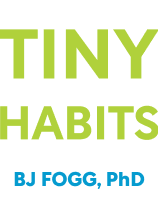

This article is an excerpt from the Shortform book guide to "Tiny Habits" by BJ Fogg. Shortform has the world's best summaries and analyses of books you should be reading.
Like this article? Sign up for a free trial here .
Want to know how to make a habit stick after you’ve developed it? Why is daily rehearsal so important? What are the five main skills needed to build on your habits?
In order to make a habit stick, rehearsal in our daily lives is crucial. Rehearsing habits helps you acquire the habit quickly and helps you remember to perform the habit.
Keep reading to learn more about how rehearsing and building upon Tiny Habits.
How to Make a Habit Stick
Any world-class athlete or musician can tell you about the importance of rehearsal, but our use of rehearsal in our daily lives is woefully inadequate. Tiny Habits author BJ Fogg believes that this technique, in particular, will be much more widely appreciated in the future. Here’s how to make a habit stick.
Rehearsing helps you to do two things: acquire the habit quickly and remember to do the habit if you’re having trouble.
Here’s how to rehearse. Think of your habit recipe. For now, let’s say it’s After I turn off the water in the sink, I will wipe the counter.
- Go to the kitchen and take out some plates. Rinse them off, turn off the water, and wipe the counter. Celebrate lavishly.
- Take the plates out again. Rinse them off, turn off the water… and so on.
- Repeat this sequence at least seven times.
- See what happens the next time you rinse off plates. Having encoded the behavior sequence through rehearsal and celebration, your brain will most likely nudge you to wipe the counter.
Broad Behavior Design Skill Sets
Zooming out, we can see that to become proficient at Behavior Design and make a habit stick, we need a full toolbelt of behavior change techniques. We can divide these techniques into five main skill sets. Remember that behavior change itself is a skill, so you can practice anything within these skill sets just like you practice your Tiny Habits.
Here are the five broad skill sets we draw on in Behavior Design:
- 1. Strategy
- 2. Clarity
- 3. Process
- 4. Environment
- 5. Attitude
1. Strategy
Strategy is knowing how to approach the behavior change process in a way that’ll work for you (or a person you’re helping). It includes selecting habits intelligently, refining them thoughtfully, and walking the line between too few and too many new habits at the same time.
The Strategy skill set includes the skills of:
- Generating options (Swarm of Bs)
- Identifying Golden Behaviors
- Manipulating the Ability dimension
Plus a new skill: Maintaining a bird’s-eye view of your habit landscape.
Pull back and scan your garden. Are any parts overgrown (too densely planted or in need of a good weeding)? Is there any space where you could plant some new habits?
To build Strategy skills:
- Follow your natural tendencies. Would you prefer to sprinkle lots of little habits throughout your day, or focus more intensively on one area? If you’re not sure, a typical Habiteer begins with three Tiny Habits and adds three new ones every month.
- Sample the possibilities. Select a few different domains of your life (work, health, relationships) and implement one new habit in each. Mix up Starter Steps and Scaled-Back habits.
- Adjust whenever needed. If a habit is no longer serving you, get rid of it. There’s no reason to continue the crochet habit you started three months ago if you’d rather be working on your jump shot.
2. Clarity
The second step in making a habit stick is to have clarity. Clarity is insight into your own motivations and needs. It’s understanding what kinds of change have the most value to you.
The Clarity skill set includes the skills of:
- Pinpointing your aspirations and outcomes
- Understanding your own motivation (“want to” vs. “should”)
Plus a new skill: Staying connected to your personal priorities.
To build Clarity skills:
- Connect the new habit to a valued identity. If you want to be a person who feels and expresses gratitude, build the habit of thanking your partner when they take out the trash. If you want to be a person who cares about the environment, build the habit of carrying your own bottle of drinking water rather than using a new plastic bottle every day.
- Choose habits that have an obvious link to your aspiration. The clearer the path from habit to aspiration, the easier it will be to remember and maintain the habit. Conversely, if there’s a habit that feels more like “I should” than “I want to,” it can help to dig down and identify the aspiration. When you dig down, you may find that actually the habit holds little personal meaning for you—perhaps it was your mother’s idea or based on what a friend did. In that case, ditch the habit and find something more meaningful.
- Focus on habits with the most potential to spark other changes. Remember Sarika and her stovetop burner Starter Step? This habit was located in the kitchen, very fertile ground for new habits. Over time, this single Tiny Habit turned into her cooking for herself regularly and keeping the formerly disastrous kitchen tidy.
3. Process
Process skills come from a deep familiarity with the mechanics of habit change.
The Process skill set includes the skills of:
- Rehearsing and refining
- Changing your approach flexibly as needed
Plus a new skill: Managing sustainable growth. This includes:
- Identifying the area of challenge.
- Finding the point between the baseline Tiny Habit and “too hard.”
- Being sensitive to day-to-day fluctuations in Ability and Motivation.
- Knowing when not to push yourself. (If you’re sick, stressed, or very time-poor, it’s not the time to grow your habit.)
To build Process skills:
- Guard against the “all in” tendency and quick self-criticism. We talked about the tendency to go “all in” on new habits back when we were talking about the pitfalls of relying on motivation. Remember that slow and steady wins the race.
- Practice taking the pressure off. Don’t do more than you want to do at any time. Don’t listen to “shoulds.” Always feel completely comfortable reverting to the tiny version.
- Closely monitor your emotional state. If you feel bored, challenge yourself. If you feel excited to do more, go with it. If you feel frustrated or annoyed, or if you start skipping days or procrastinating, scale back.
- Calibrate your celebration to your effort. If you overdo it at any point (say if you get inspired and add 20 pushups all at once), scale up the celebration. You want your brain to keep associating the action with positive feelings. If you go too far and negative emotions arise, counterbalance them with a souped-up celebration. You could even pull out your Power Celebration.
4. Environment
The fourth element in making habits stick is the Environment Skill. The Environment skill set is the ability to design aspects of your environment to support your new habits.
The Environment skill set includes the previous skills of:
- Prompt design
- Employing new tools and resources (for example, better floss or sharp kitchen knives)
Plus a new skill: Design for accessibility. To design for accessibility:
- Ask yourself the discovery and breakthrough questions (Chapter 3): What is making this behavior difficult? and How can I make this easier?, but this time with a focus on the environment.
- Do you need a visual cue (for example, putting your vitamins out where you can see them)?
- Do you need to communicate something to people in the environment? (Would it help to tell your husband, “Please don’t tidy my vitamins when I leave them out”?)
- Do you need to reorganize something so it’s simpler to execute your habit? Simple snags in the sequence can derail a promising new habit. (If you need to take your vitamins with food, keep them in the cupboard where you store the plates.)
To build Environment skills:
- Develop an eye for environmental design in a range of situations. Start analyzing environments in terms of potential hurdles for new habits. Try to engage in environmental design both before you start your new habit and in an ongoing way as your new habit takes root.
- Be creative. Maybe you need to organize your environment in unconventional ways. Do you need to store dental floss in your handbag, or your meditation cushion next to the computer?
> An example of environmental design is the SuperFridge, which Fogg implemented with his partner years ago. Through the SuperFridge, Fogg and his partner both lost 15 percent of their body weight and have stayed at their ideal weight with no effort.
> This is how SuperFridge works:
> Once a week, fill your fridge with appealing-looking healthy snacks and meal prep components. The first thing you see when you open the fridge will be cleanly stacked, colorful, healthy food options: washed and cut vegetables, cooked healthy grains, fresh fruit, boiled eggs, yogurt, and so on.
> For your SuperFridge, tailor these suggestions to yourself so there are healthy options that appeal to you. This way no bad options are ever stored in the fridge. The rule is: If it’s in the fridge, you can eat it whenever you want.
5. Attitude
The final set of skills you need to know to make a habit stick are Attitude Skills. Attitude skills are all of the psychological skills related to behavior change.
The Attitude skill set includes the previous skills of:
- Maintaining a curious, nonjudgmental attitude about behavior change
- Managing your expectations and the expectations of those around you
- Fluency in the language of celebration
- Patience
Plus a new skill: Identity shift. As soon as you start genuine behavior change, identity comes into play. Perhaps you’re moving from “stuck in my ways” to “unafraid of change.” Perhaps you’re moving from “overwhelmed” to “successful.”
Identity shifts can be scary. We hold onto stable identities for social reasons. A stable identity makes us more predictable to those around us. It’s important for group survival that everyone knows their role and the roles of others.
Identity change can happen unconsciously at first. Our brains try hard to construct a coherent identity. If you start going to the gym, you become “the type of person who goes to the gym.” This identity then triggers the formation of other habits that conform to it: Perhaps you become “the type of person who monitors their weight-lifting reps” or “the type of person who cares about pre-workout and post-workout nutrition.” This is one of the reasons that a small change can snowball into something much bigger.
To build Attitude skills:
- Consider the statement “I’m the type of person who…” Finish it with the identity you’re trying to cultivate.
- Surround yourself with people who already have this identity. Go to events, join groups, and so on.
- Learn the specific vocabulary related to this identity. This acts as an entry point. Chatting with the most knowledgeable members of the group. This is another entry point.
- Wear clothing (perhaps a T-shirt) that proclaims this identity publicly.
- Introduce the identity into your social media. Update your status, follow people, or join a group.
- Once you’ve built up some skills, begin teaching others who are entering this domain.
Building on Habits Once They’re Established
Habits Either Grow or Multiply. Habits that grow expand naturally. One example of this is Habiteer Sukumar’s post-tooth-brushing plank, which started at five seconds and grew to five minutes.
These habits can’t grow indefinitely, because you have other things you need and want to do with your life. Unless you’re a monk, spending five hours a day meditating will probably interfere with the rest of your life. At some point, growth habits will hit a limit and stay there.
Habits that multiply spark other habits, like dandelion seeds blowing in the wind and landing somewhere else. They create an ecosystem of different related behaviors. For example, remember the Maui Habit from the Introduction? This habit doesn’t grow larger, but it can seed lots of other positive habits throughout the day.
Aim to plant a balanced garden of habits that grow and habits that multiply.
Is there a set timescale for establishing new habits? Lots of people, including behavior change specialists, believe there’s a “magic number” of days or repetitions for forming new habits.
This is false. The speed at which you’ll be able to form new habits depends on the interactions between many complex factors. To give yourself the best chance to succeed quickly: Celebrate intensely (remember your “Power Celebration” from early in this chapter), rehearse, let habits take root and expand naturally, and relax judgment.
You can’t force a plant to grow by trash-talking it, pressuring it to go faster, or making it feel bad. Treat your habit—and yourself—with gentleness and respect.

———End of Preview———
Like what you just read? Read the rest of the world's best book summary and analysis of BJ Fogg's "Tiny Habits" at Shortform .
Here's what you'll find in our full Tiny Habits summary :
- How you can successfully create new habits that stick
- Why you don't need motivation, just science
- Why even flossing one tooth should be considered a victory






